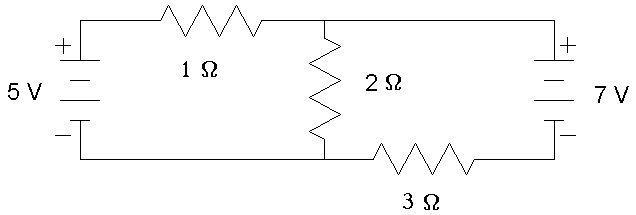
First Name: ___________________ Last Name: ____________________ Section: _________
a. What is the electric current carried by the beam? (5 pts.)
b. What is the magnetic field outside the beam, 30 cm from its center? (5 pts.)
c. What is the magnetic force on an electron (me = 9.1 x 10-31 kg), 30 cm from the center of the beam and moving with a velocity 1% the speed of light parallel to the beam? (5 pts.)
d. What is the radius of curvature of the orbit of the electron in part c above? (5 pts.)
e. What is the kinetic energy (in eV) of the electron in part c above? (5 pts.)
First Name: ___________________ Last Name: ____________________ Section: _________

a. At what frequency f does the current I oscillate? (5 pts.)
b. What is the current I just after the switch closes? (5 pts.)
c. At what time after the switch closes does the current I first reach its maximum value? (5 pts.)
d. What is the maximum value of the current I? (5 pts.)
e. What is the current I at t = 0.4 s? (5 pts.)
First Name: ___________________ Last Name: ____________________ Section: _________
a. What is the wavelength of the wave in the air? (5 pts.)
b. What is the wavelength of the wave in the medium? (5 pts.)
c. What is the angle of the refracted wave in the medium? (5 pts.)
d. What is the angle of the reflected wave in the air? (5 pts.)
e. What is the phase shift of the reflected wave? (5 pts.)
First Name: ___________________ Last Name: ____________________ Section: _________
a. If the converging lens forms a real image of the light source at a distance of 60 cm from the lens, what is its focal length? (5 pts.)
b. You now put the two lenses next to each other and observe a real image of the light source at a distance of 2 m. What is the effective focal length of the combination of lenses? (5 pts.)
c. From the data above, what focal length do you calculate for the diverging lens? (5 pts.)
d. If you now look at the light source through the diverging lens, how far behind the lens does the source appear to be? (5 pts.)
e. Which of the following describes the image in d above: real, virtual, upright, inverted? (5 pts.)
First Name: ___________________ Last Name: ____________________ Section: _________
a. What is the diameter of the atom according to the Bohr model? (5 pts.)
b. What is the de Broglie wavelength of the electron in the atom? (5 pts.)
c. What is the wavelength of the photon that is emitted when the electron decays to its ground state? (5 pts.)
d. What is the radius of the nucleus of this atom? (5 pts.)
e. If the nucleus collides with an antiproton and annihilates, forming two identical gamma rays, what is the wavelength of each gamma ray? (5 pts.)
First Name: ___________________ Last Name: ____________________ Section: _________